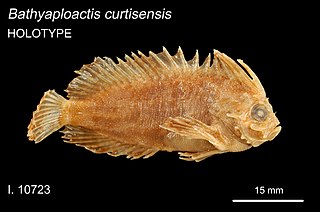
The red velvetfish is a species of marine ray-finned fish, it is the only species in the monotypic genus Gnathanacanthus and monogeneric family Gnathanacanthidae. This species is endemic to the inshore waters of western and southern Australia.

Scorpaenoidei is a suborder of ray-finned fishes, part of the order Scorpaeniformes, that includes the scorpionfishes, lionfishes and velvetfishes. This suborder is at its most diverse in the Pacific and Indian Oceans but is also found in the Atlantic Ocean.

Congiopodidae, commonly known as pigfishes, horsefishes and racehorses, is a family of ray-finned fish classified with in the order Scorpaeniformes. These fishes are native to the Southern Hemisphere.

Little velvetfishes or simply velvetfishes are a family, the Aploactinidae, of marine ray-finned fishes classified within the order Scorpaeniformes. They are small fish that have skin with a velvet texture. They live on the sea bottom close to the shore, at depths of up to 100 metres (330 ft). They are found in the Indo-Pacific region.

Apistinae, the wasp scorpionfishes, is a subfamily of venomous, marine ray-finned fishes belonging to the family Scorpaenidae, the scorpionfishes and related species. These fishes are native to the Indian Ocean and the western Pacific Ocean.

The wasp-spine velvetfish, also known as the dwarf velvetfish, is a species of marine ray-finned fish, a velvetfish belonging to the family Aploactinidae. It is the only member of the monotypic genus Acanthosphex. This species is found in the Indo-Pacific from India to the Gulf of Thailand.
The visitor, also known as the sandpaper velvetfish,is a species of marine ray-finned fish, a velvetfish belonging to the family Aploactinidae. It is the only member of the monotypic genus Adventor. This species is found the Pacific Ocean waters along the coasts of Papua New Guinea and Australia.
The dusky velvetfish is a species of marine ray-finned fish, a velvetfish belonging to the family Aploactinidae. It is the only member of the monotypic genus Aploactis. This species is found in the western Pacific Ocean.

Bathyaploactis is a genus of marine ray-finned fish, velvetfish belonging to the family Aploactinidae. The genus is endemic to the waters around Australia.

Erisphex is a genus of marine ray-finned fish, velvetfishes belonging to the family Aploactinidae. The genus is found in the Indian and western Pacific oceans.

Kanekonia is a genus of marine ray-finned fish, velvetfishes belonging to the family Aploactinidae. The genus is found in the western Pacific and eastern Indian oceans.
The rare velvetfish is a species of marine ray-finned fish, a velvetfish belonging to the family Aploactinidae. It is known only from the coasts of Queensland and New South Wales in Australia. It is the only member of the monotypic genus Matsubarichthys.
The threefin velvetfish is a species of marine ray-finned fish, a velvetfish belonging to the family Aploactinidae. This species is found the western Pacific Ocean where it has been found on reefs. This species grows to a length of 5 centimetres (2.0 in) TL. This species is the only known member of its genus.

Paraploactis is a genus of marine ray-finned fish, velvetfishes belonging to the family Aploactinidae. The genus is found the Indo-Pacific.
The deceitful velvetfish is a species of marine ray-finned fish, a velvetfish, belonging to the family Aploactinidae. This species is endemic to the oceans around Australia. This species is the only known member of its genus.
Prosoproctus is a genus of velvetfish native to the South China Sea where it occurs at depths of from 69 to 82 metres. The only known member of the genus is Prosoproctus pataecus.
Pseudopataecus is a genus of marine ray-finned fish, velvetfishes belonging to the family Aploactinidae. This genus is endemic to the waters around Australia.
Ptarmus is a genus of marine ray-finned fish, velvetfishes belonging to the family Aploactinidae. This genus is endemic to the waters of the western Indian Ocean.
Sthenopus is a monotypic genus of marine ray-finned fish, a velvetfish belonging to the family Aploactinidae. It is found in the western Pacific Ocean where it is known from China and Thailand. The only known member of this genus is Sthenopus mollis.

Xenaploactis is a genus of marine ray-finned fish, velvetfishes belonging to the family Aploactinidae. This genus is found in the western Pacific Ocean and the eastern Indian Ocean.











